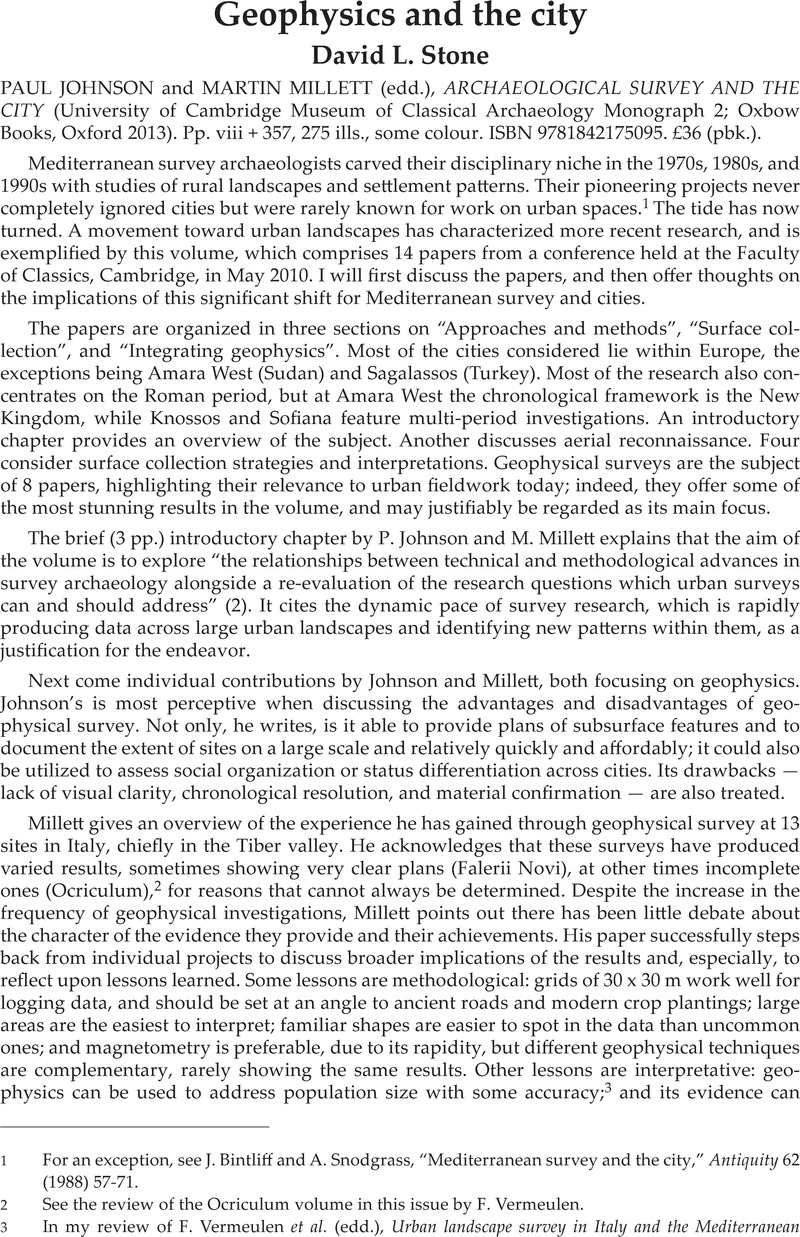No CrossRef data available.
Article contents
Geophysics and the city - PAUL JOHNSON and MARTIN MILLETT (edd.), ARCHAEOLOGICAL SURVEY AND THE CITY (University of Cambridge Museum of Classical Archaeology Monograph 2; Oxbow Books, Oxford 2013). Pp. viii + 357, 275 ills., some colour. ISBN 9781842175095. £36 (pbk.).
Published online by Cambridge University Press: 27 November 2014
Abstract

- Type
- Reviews
- Information
- Copyright
- Copyright © Journal of Roman Archaeology L.L.C. 2014
References
1 For an exception, see Bintliff, J. and Snodgrass, A., “Mediterranean survey and the city,” Antiquity 62 (1988) 57–71 CrossRefGoogle Scholar.
2 See the review of the Ocriculum volume in this issue by F. Vermeulen.
3 In my review of Vermeulen, F. et al. (edd.), Urban landscape survey in Italy and the Mediterranean (Oxford 2012)CrossRefGoogle Scholar in JRA 26 (2013) 641 Google Scholar, I noted that issues of urban population size were tackled without reference to geophysical evidence. By contrast, it is a pleasure to acknowledge the thoughtful way in which the data are deployed for this purpose in the present volume.
4 Bowes, K. et al., “Preliminary report on Sofiana/mansio Philosophiana in the hinterland of Piazza Armerina,” JRA 24 (2011) 448 Google Scholar.
5 Compare fig. 13.4 in this volume with fig. 5, p. 175, in Mogetta, M. and Becker, J., “Archaeological research at Gabii, Italy: The Gabii Project excavations, 2009-2011,” AJA 118 (2014) 171–88CrossRefGoogle Scholar.
7 See, e.g., Kvamme, K., “Geophysical surveys as landscape archaeology,” American Antiquity 68 (2003) 435–57CrossRefGoogle Scholar; Conyers, L. and Leckebusch, J., “Geophysical archaeology research agendas for the future: some ground-penetrating radar examples,” Archaeological Prospection 17 (2010) 117–23Google Scholar; V. Thompson et al., “Situating remote sensing in anthropological archaeology,” ibid. 18 (2011) 195-213.
8 Thompson, V., Arnold, P. and Vanderwarker, A., “Geophysical investigations at Teotepec, Mexico (1000 B.C.–A.D. 1000),” JFA 34 (2009) 446 CrossRefGoogle Scholar.
9 Keay, S. et al., “ Falerii Novi: a new survey of the walled area,” PBSR 68 (2000) 86–87 Google Scholar; Hay, S. et al., “ Falerii Novi: further survey of the northern extramural area,” PBSR 78 (2000) 6–7 Google Scholar; Opitz, R., “Integrating lidar and geophysical surveys at Falerii Novi and Falerii Veteres (Viterbo),” PBSR 77 (2009) 9–13 Google Scholar. Cf. Millett, M., “Urban topography and social identity in the Tiber Valley,” in Roth, R. and Keller, J. (edd.), Roman by integration (JRA Suppl. 66, 2007) 71–82 Google Scholar.
10 Landscape modifications similar to those discovered at Teotepec could conceivably be detected in the Roman world through geophysics. The leveling and infilling of the Forum Romanum comes to mind, even though this was discovered through geological coring: Ammerman, A., “On the origins of the Forum Romanum ,” AJA 94 (1990) 627–45CrossRefGoogle Scholar; Hopkins, J. N., “The creation of the Forum and the making of monumental Rome,” in Robinson, E. C. (ed.), Papers on Italian urbanism in the first millennium B.C. (JRA Suppl. 97, 2014) 29–61 Google Scholar.


